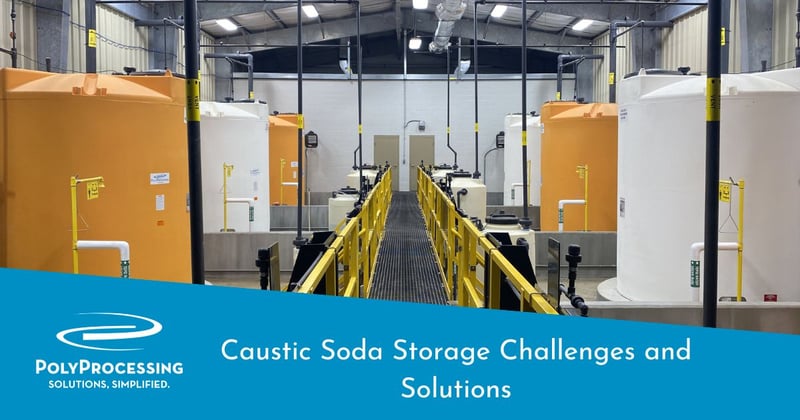Caustic Soda Storage Challenges and Solutions
Sodium hydroxide, also known as caustic soda or liquid lye, is commonly used to adjust pH levels in water and wastewater and can easily change hard water to a much closer approximation to neutral when injected into the water treatment system. Caustic soda can act as a corrosion inhibitor without the uneven distribution of calcium carbonate. Caustic soda is also used in the manufacturing of chemicals, rayon, cellophane, paper, detergents, soaps, and a variety of other products.
Caustic Soda Storage Challenges

Sodium hydroxide is a “slippery” chemical that seeks leak paths within storage tanks. It is also extremely corrosive to human tissue and highly toxic if ingested, so it must be handled with care. Finally, if caustic soda is not maintained and stored at a specific temperature, it will crystallize and turn into a solid. If you choose to store the chemical outdoors, it will be necessary to use heat tracing and insulation to maintain the proper temperature.
Given the hazardous properties of caustic soda, it’s important to use specialized storage solutions that are specifically engineered for storing the chemical.
Storage Solutions for Caustic Soda
Many facilities use stainless steel tanks to store caustic soda — and there are good reasons to use steel tanks. The steel walls resist corrosion, the tanks can be placed indoors or outdoors, and heating kits are easy to apply. As a general rule, the resistance to caustic solutions increases with increasing nickel content in the stainless being used.
However, stainless steel tanks also cost three to four times as much as necessary. Cross-linked polyethylene (XLPE) tanks provide the same performance advantages as stainless steel tanks, but they come with a 75-percent cost savings. For the price of one stainless steel tank, you can purchase four XLPE tanks to do the same job, and just as well.
SAFE-Tank® Double-Wall Containment
Since sodium hydroxide is so corrosive, proper secondary containment is essential. Poly Processing's SAFE-Tank can provide the necessary secondary containment solution to safely store caustic soda. This “tank within a tank” extends the margin of safety by providing a system with 110% secondary containment.
Poly Processing’s SAFE-Tank system provides the same double-wall tank system and resistance to corrosion as stainless steel, while providing benefits that steel tanks can’t offer:
- Smaller footprint — our double-wall system eliminates the need for large concrete berms.
- Lower long-term costs — no concrete berm means less maintenance or repair over the life of your storage system.
- Conservation of lost chemical — if a leak occurs, the double-wall system contains any leaked chemical, preventing chemical (and financial) loss.
The SAFE-Tank also works well with a heat maintenance kit, and the double wall functions as an additional measure against heat loss. Our engineers can work with you to determine the ideal solution to maintain proper temperatures.
IMFO® Tank
To eliminate sidewall penetrations and minimize potential leak sources for this “slippery” chemical, the IMFO Tank is recommended. IMFO systems are ideal for sodium hydroxide systems, because the flange is actually a molded part of the tank, and not an insert that could leak or fail.
The IMFO also ensures long-term performance of the overall system, since it eliminates the need to drill into the sidewall of the tank and install a mechanical fitting, which can create a maintenance issue for this chemical.
Poly Processing can also provide heat trace systems and polyurethane insulation to solve the issue of crystallization at lower temperatures.
With chemical specific NSF 61 certification, high density cross linked polyethylene offers the tank strength required to safely store caustic soda while providing a cost-effective long tank life.
Download the sodium hydroxide storage guide for more information.
- December 12, 2022
- Topics: Chemicals
About Poly Processing
Posts By Topic
Tech Talk Podcast Episodes
Subscribe By Email
Recent Posts
- Installation Tips for Chemical Storage Tanks: Site Preparation and Offloading
- Understanding pH and Chemical Concentration When Choosing a Chemical Tank
- Maximizing Fill Efficiency: Selecting the Optimal Fill Line System
- Chemical Storage Tanks: A Quick Guide for End Users
- Popular Customization Options for Chemical Storage Tanks
Tank Configurator

Find the recommended tank and system components for your chemical storage challenge.
Configure a Tank Package







